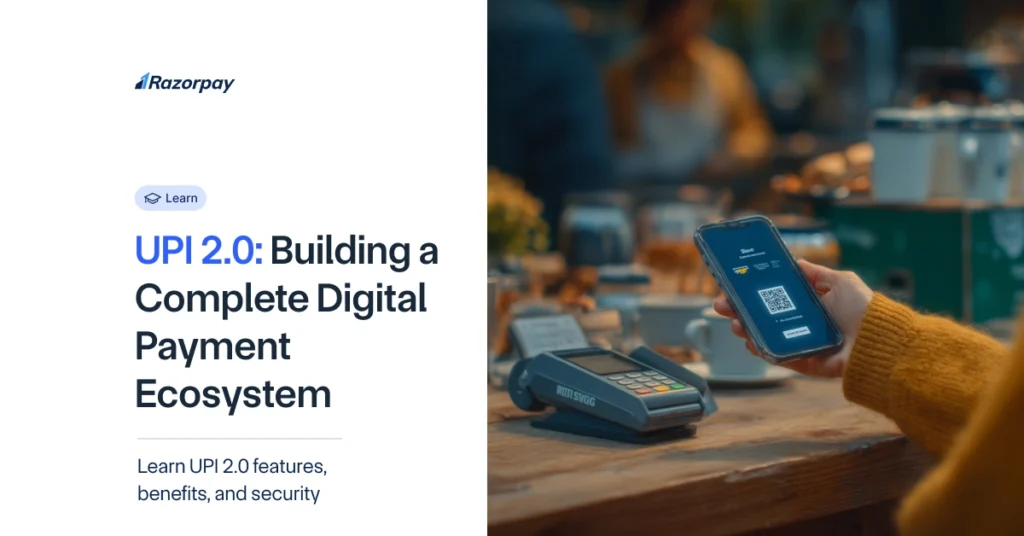India’s economy saw the dawn of a new era when the National Payments Commission of India (NPCI) introduced UPI. Although people were vary of using digital payment modes in the beginning, the various updates and the government’s continuous efforts to link UPI with banking services bore fruit and today, a whopping 85% of the businesses use UPI to transact and conduct business. The widespread adoption of UPI led to the creation of UPI 2.0, a more improved and secure counterpart to the original version. UPI 2.0 comes equipped with novel security features and accommodates several banking services, making it easy for businesses to transact. This article throws light on how UPI 2.0 aims to completely detach businesses from a cash only market to a totally digital payment ecosystem.
Key Takeaways
UPI 2.0 is more secure, faster and efficient version of the UPI ecosystem.
Overdraft facility, one-time mandate, invoice in box, signed intent and QR code, linking multiple accounts, biometric authentication and offline payments are some of the key highlights of this latest version of the UPI, among the others.
By including these features, the NPCI aims to create a cashless, completely digital payment ecosystem in the years to come.
Razorpay’s payment solutions are compliant with all the necessary digital payment features in UPI 2.0. Aimed to make transactions easy for merchants and businesses regardless of their size.
What is UPI 2.0?
UPI 2.0 refers to the renewed version of UPI, equipped with additional features to support both consumers and businesses. This version is more secure, fast and complies with the latest AML laws, making it a reliable payment platform for both consumers and merchants. UPI 2.0 was developed with the aim of improving user experience and providing robust and secure transaction options. When UPI was first introduced, it had a lot of flaws. This improved version comes with additional features like one-time mandates, overdraft facility, etc.
Key Features of UPI 2.0 for Businesses
One of the major drawbacks of UPI 1.0 was that it was just meant to facilitate digital financial transactions. Due to it’s limited reach and lesser optimised framework, merchants found it it difficult to conduct business transactions, digitally. This led them to heavily rely on cash transactions and internet banking. In UPI 2.0, NPCI made several improvements to accommodate business requirements, making it one of the most sought-after payment technologies by merchants. UPI 2.0 bridged the technical and technological gaps in UPI 1.0 and today, one may observe that most businesses prefer to resort to UPI over any other payment method in India. Here are some of the key improvements made to the UPI 2.0 framework.
One-time Mandates
One time mandate refers to a customer authenticating monthly UPI payments for subscription-based services and businesses, only once. With this update, consumers can link their UPI account with their bank account and set it up for automatic monthly payments depending on their payment preference.
How Does This Help Your Business?
UPI 2.0’s one-time authentication allows businesses to set up secure, regular transactions without having to approach their customers every now and then for approval. It simplifies subscription billing and recurring payments, reducing the churn-rate and helping move customers further down the sales funnel.
Overdraft Facility
UPI 2.0 comes equipped with the option to link your customers’ bank accounts with their UPI accounts. This way, they can use the overdraft facility – an option to borrow limited credit from their banks when funds are insufficient to conduct business transactions.
How This Helps Your Business?
If your business offers services on a subscription basis, customers with access to overdraft services from their bank will be able to make regular payments despite having insufficient funds in their account, ensuring that your payments are not delayed. This feature enables customers to complete high-value transactions, boosting sales and supporting credit-based purchases.
Invoice In Box
This is one of the key highlights of UPI 2.0. If your merchant account is connected to a UPI app, you can now share an invoice of your transaction with your customer through the app without having to depend on external tools to do so.
How This Helps Your Business?
When you share invoice with your customer instantly, it shows how reliable your business is. Timely delivery of your invoice also proves the genuineness of your business, earning your customers’ trust.
Signed Intent & QR Codes
UPI 2.0 uses digitally signed intents and QR codes to authorize and verify the authenticity of merchants and businesses. This quickens the transaction speed and expedites the business process, prevents fraud and maintains the sanctity of the transaction.
How This Helps Your Business?
By linking your business account to a UPI app, your business is automatically set up to send and receive money through authorized channels. A digitally signed intent/QR codes represent the trustworthiness of your business, earning your customer’s loyalty and trust.
Linking Multiple Accounts
Customers can now enlist multiple accounts on their respective UPI apps. This ensures timely payments, leading to successful business transactions.
How This Helps Your Business?
When customers get to link multiple accounts, businesses can expect lesser wait time to process payments, increasing transaction efficiency and success rates.
Higher Transaction Limits
The new version of UPI, UPI 2.0, supports transaction of higher amounts, above the default ₹ 1 Lakh limit, making it easy for businesses to deal with high-value transactions.
How This Helps Your Business?
With higher amounts, you can be assured that your transactions will be safe, secure and conducted without hassles due to compliance issues.
UPI 2.0 also comes equipped with features like biometric authentication and offline payments, both of which were included to ease business transactions.
How UPI 2.0 Builds a Complete Digital Ecosystem?
With UPI 2.0, the government aims to uplift home-grown businesses by enabling them to operate transparently with the help of increased security measures and relaxed transactional rules, making digital payments more accessible and easy-to-use. Let’s take a look at how it helps in building a completely digital ecosystem and how both customers and businesses benefit from it.
Key Features of UPI 2.0 That Contribute To A Complete Digital Payment Ecosystem
A unified payment infrastructure
UPI 2.0 supports both peer-to-peer and peer-to-merchant and merchant-to-peer transactions, widening it’s user base and enabling a wide range of digital use cases.
Advanced Payment Features
Features such as overdraft linking, one-time mandates for recurring payments, invoice in inbox, and signed QR codes create a flexible, secure, and transparent transaction experience that meets the needs of consumers and businesses alike.
Enhanced Security and Trust
Digital signatures on transaction intents and QR codes prevent fraud, while biometric authentication adds another layer of security, instilling confidence among users and merchants and reducing payment disputes.
Wider Financial Inclusion
Offline payments and easy linking of multiple bank accounts empower users in remote or underserved areas, breaking connectivity and infrastructure barriers and integrating them into the digital economy.
Interoperability and Open Architecture
Being an open-source model, UPI enables fintechs, banks, and merchants to innovate on top of the platform, fostering a competitive yet collaborative environment that drives adoption and continuous improvements.
Data-Driven Ecosystem
Rich transaction data and digital invoicing enable smarter financial management, targeted marketing, and personalized customer interactions, driving better business decisions and improving consumer satisfaction.
Why Businesses Must Use Razorpay’s UPI 2.0 Services?
Razorpay’s payment framework has been programmed to accommodate the latest updates made in digital payments. It supports all the latest features attached to UPI 2.0.
Key Reasons for Merchants to Use Razorpay
Wide Payment Options: Razorpay supports a variety of payment methods, including UPI (with UPI 2.0 features), credit/debit cards, net banking, wallets, and EMI, enabling merchants to cater to a broad customer base.
Advanced Security: Razorpay uses encryption, PCI DSS compliance, signed QR codes, and other UPI 2.0 security features to ensure safe transactions and protect merchants and customers from fraud.
Instant Settlement & Reconciliation: Razorpay provides faster settlements and automated reconciliation tools, reducing manual work, accelerating cash flow, and improving financial management for merchants.
Optimized Payment Success: Features like multi-bank routing and Turbo UPI improve payment success rates, minimize transaction failures, and enhance customer experience.
Scalable and Customizable: Razorpay scales with business growth, supporting diverse industries from startups to large enterprises, and offers customizable workflows for subscriptions, invoicing, and payouts.
Conclusion
UPI 2.0 is just a stepping stone in the long journey of making India independent of cash-based transactions. With the slew of secure measures taken to protect transactions of all shapes and sizes, NPCI aims to make UPI a robust, impenetrable platform. Razorpay’s payment solutions are programmed to adapt to any upgradation without compromising the system’s integrity. With Razorpay, you get your business future-ready and efficient.
Make Your Business UPI 2.0 friendly today!
FAQs
Can small businesses also use UPI 2.0 features like mandates?
Yes, small businesses can use UPI 2.0 features like mandates. By activating this feature, smaller businesses can encourage their customers to monthly subscription payments.
Is UPI 2.0 secure for high-value transactions?
Yes, it is secure for high-value transactions, due to it’s enhanced security features.
Does Razorpay support UPI 2.0 features?
Yes, Razorpay supports UPI 2.0 and its advanced features. Razorpay was one of the first payment aggregators to launch UPI payments and UPI 2.0 features, including one-time mandates for recurring payments, overdraft facility linkage, invoice in inbox, signed intent and QR codes, and multi-account linking.


